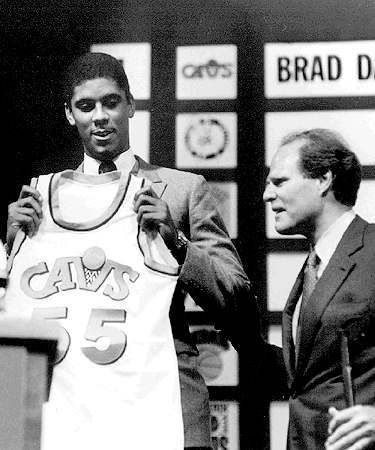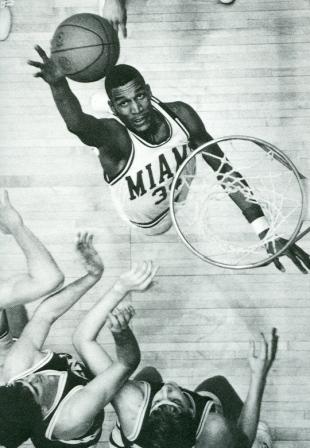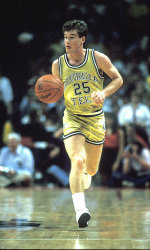 Cavs Archive
Cavs Archive  June 17, 1986
June 17, 1986
 One of the finest installments of ESPN’s impressive “30 for 30 Series” is titled June 17, 1994. Following an unorthodox format of splicing a myriad of live television clips, it weaves together the strands of a memorable day in American sports and culture, highlighted by the pursuit and arrest of O.J. Simpson for the murder of his wife Nicole.
One of the finest installments of ESPN’s impressive “30 for 30 Series” is titled June 17, 1994. Following an unorthodox format of splicing a myriad of live television clips, it weaves together the strands of a memorable day in American sports and culture, highlighted by the pursuit and arrest of O.J. Simpson for the murder of his wife Nicole.
While not as dramatic, on the same date 25 years ago this week, June 17 marked the nexus at which multiple storylines collided and allowed the Cleveland Cavaliers to relaunch their wobbly franchise.
Though the term “relaunch” is a smidge of an understatement. What the Cavs did that day wasn’t so much revamp their team as create a new one.
June 17 was the date of the 1986 NBA Draft, and proved to be the only time in Cleveland sports history that draft day actually was what everyone hypes it up to be. In the span of a single day, the Cavaliers acquired a core of players that would personify the franchise well into the following decade while utilizing a new brand of leadership that had been missing for the previous decade.
While landing LeBron James in 2003 certainly altered the course of the franchise in a dramatic way and the upcoming draft certainly will leave its mark on team history, LeBron and whoever comes next are single players who were acquired with one stroke. Seventeen years earlier, the Cavs created a championship-caliber team with a myriad of interconnected motion not unlike the intricate inner workings of a pocket watch.
All of this quite shocking considering the Cavs went into that 1986 draft without a head coach. Or for that matter, a general manager.
Cavs fans awoke on that June 17 to three blockbuster pieces of news. Gene Littles, who’d served as an interim coach for the final weeks of the previous season after George Karl was fired, had resigned amidst uncertainty within the franchise to become the top assistant for the Chicago Bulls.
Secondly, after a year of waiting, the Cavs finally had learned that their 1985 second-round pick, John “Hot Rod” Williams, could join the team. The day before, Williams had been acquitted of charges of point-shaving while playing at Tulane and was now free to begin his professional career. The Cavs had immediately sent a contract to New Orleans and Williams had signed it.
But the biggest piece of news transpired just before midnight. Minutes before the deadline, the Cavs had acquired the No. 1 overall pick in the draft, trading center Roy Hinson to Philadelphia along with a wad of cash. The Cavs would now have two of the first eight picks in a draft that was shaping up to be the most memorable in team history.
And steering the ship in the front office at this critical moment was Director of Player Personnel Barry Hecker, who two years earlier had been coaching a high school team in Salt Lake City.
“That is roughly the equivalent of a buck sergeant handling the duties of the army chief of staff,” Bob Dolgan wrote in the Plain Dealer, “or of a police reporter taking over as a newspaper’s editor and publisher for a day.”
Ironically, Cavs owner Gordon Gund knew exactly whom he wanted to run the Cavs’ show in the front office, but he couldn’t have him until after this decisive day was over.
Wayne Embry had served in the Milwaukee Bucks’ front office for more than a decade and now was serving as a consultant for the Indiana Pacers going into the ’86 draft. Gund had offered him the Cavs’ GM job and Embry was prepared to take it, but he had to get through the draft with Indiana first.
Sound awkward? Oh, but it only gets better.
The draft began and the Cavs were on the clock. There’d been much debate over which direction they should go, but a decision was finally made and from the outside looking in, Embry approved of it.
The Cavs selected soft-spoken center Brad Daugherty from North Carolina, instantly souring the mood at a draft party at the Stouffer Hotel downtown, where fans had been hoping for phenomenal Maryland forward Len Bias.
Bias was forecasted to become a spectacular playmaker along the lines of Magic Johnson or Michael Jordan. With the energetic World B. Free on his way out the door, the Cavs needed somebody to score and provide some dazzle. Bias looked like the perfect fit.
Still others were upset with the move that landed Daugherty. Roy Hinson had been the Cavs’ top pick in 1983 and had enjoyed a breakthrough season in 1985-86, averaging just under 20 points and eight rebounds per game.
PD columnist Bill Livingston criticized the Cavs first for trading away Hinson, whom he felt was just beginning to develop into a star, and then for not selecting Bias. “The hot dogs were pricey,” Livingston wrote. “But the Cavs are no closer to cutting the mustard.”
He would be wrong on both counts.
Hinson was never that good again. Both his scoring and rebounding averages dropped dramatically the following season and never again approached his totals in his last season in Cleveland.
And 24 hours after the Boston Celtics snagged him with the second pick, Bias was dead of a cocaine overdose.
The Cavs had hit the jackpot. And they still had a few dice to throw.
With a center to build the roster around, they now had the opportunity to grab another player who could provide many of the same elements as Bias.
Just over an hour after snagging Daugherty, with the eighth pick, they selected Ron Harper, a Dayton native from Miami of Ohio, where he’d dominated  Mid-American Conference opponents.
Mid-American Conference opponents.
 Just as Daugherty was an upgrade over Hinson, Harper would serve to replace crowd-pleasing Free, who would only play two more seasons.
Just as Daugherty was an upgrade over Hinson, Harper would serve to replace crowd-pleasing Free, who would only play two more seasons.
Already, this had been a grand day for the Cavaliers. But they had one more move to make. And it was their best.
With a rock-solid center and a dynamic playmaker, they now needed someone to tie the two together – a player who could serve as a field general on the floor.
Enter Mark Price, the tiny point guard out of Georgia Tech who’d been one of the stars of the Atlantic Coast Conference just as the league rose to the most reputable in college basketball. The Dallas Mavericks had selected Price with the first pick of the second round with the understanding that they’d immediately trade him to Cleveland. And within minutes, that’s what they did - for chicken feed: a second-round pick three years later and a measly $50,000.
Ironically (or not, depending on who you believe), just before Dallas drafted Price, Embry was on the phone trying to acquire him for the Pacers. In fact, he thought he’d landed the choir-boy point guard, only to receive a call back telling him that the Mavericks had just made a deal with the Cavs instead.
For years afterward, the Pacers’ front office steamed, suspecting Embry didn’t go full force to get Price for Indiana so he could keep him for himself in Cleveland.
Price. Harper. Daugherty. Williams. All in 24 hours.
The next day, Embry officially became the GM. Three weeks after that, he named Lenny Wilkens as the Cavs’ new coach.
And we were off to the races.
Red Auerbach, himself aglow from having landed Bias for his world-champion Celtics, stated that the Cavs had improved themselves more than any other team.
Indeed they had.
Scripted perfectly, Harper and Daugherty replaced their counterparts, Free and Hinson, as the team’s leading scorers. Williams was right behind them at 15 points per contest. Price missed a month after an emergency appendectomy and never started a game, but still showed promise playing 18 minutes a game backing up veteran John Bagley at the point.
The Cavs only improved their record by two games in 1986-87, but vaulted to the playoffs the following spring, beginning a stretch of eight postseason appearances in nine years.
All begun on June 17, 1986.
Gordon Gund called it “the most pivotal week in franchise history.”
A quarter-century later, it still is.
This is the fourth in a series of articles celebrating the 25th anniversary of the amazing Cleveland sports calendar year of 1986.
- NBA Announces 2013-2014 Schedule
- Browns Ink Sharknado
- Sharknado A No-Show For Rookie Camp
- Trent Richardson Out Until Training Camp
- Browns Sign Brandon Jackson
- Carrasco Suspended Eight Games
- Browns Add to Wide Receiver Depth with David Nelson
- Browns Need to Learn from Past Draft Mistakes
- Browns Release Chris Gocong and Usama Young
- Browns Missing on Grimes Disappointing, But Not The End
The TCF Forums
- Official- Browns Coach Search/Rumors
HoodooMan (Tuesday, January 21 2014 1:32 PM) - Movies coming out
rebelwithoutaclue (Tuesday, January 21 2014 12:56 PM) - 2015 Recruiting
jclvd_23 (Tuesday, January 21 2014 12:38 PM) - The 2014 Offseason Thread
Larvell Blanks (Tuesday, January 21 2014 12:25 PM) - Chris Grant's first 3 drafts
Kingpin74 (Tuesday, January 21 2014 10:13 AM) - Mike Brown
YahooFanChicago (Monday, January 20 2014 11:15 PM) - 2014 Hoops Hockey Hijinx
jpd1224 (Monday, January 20 2014 4:44 PM) - 2014 Recruiting
jclvd_23 (Monday, January 20 2014 2:26 PM) - Wish List - #4 Pick
Hikohadon (Monday, January 20 2014 1:26 PM) - #1 overall pick Anthony Bennett
TouchEmAllTime (Sunday, January 19 2014 1:28 PM)



